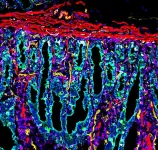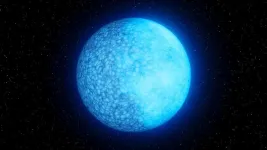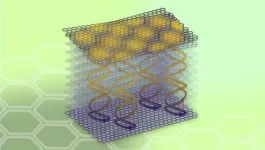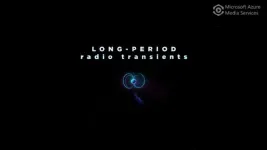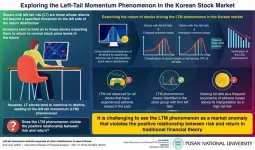(Press-News.org) Early in pregnancy, something strange happens in the uterus: Cells from the fetal side of the developing placenta invade the uterine endometrium and work with the mother’s immune system to remodel the arteries.
“When I first read about it, I thought, ‘This is so bizarre,’” said Stanford Medicine pathologist Michael Angelo, MD, PhD.
Humans’ immune systems usually attack unfamiliar cells, which would theoretically pose a problem for a developing pregnancy. But on the mother’s side of the growing placenta, the arteries incorporate cells that genetically match the embryo, just one of several unusual events in the unique cooperation required to form the only temporary human organ. (That’s right, the placenta is an organ!)
“There is nothing else like this in human biology,” Angelo said.
His curiosity piqued, Angelo decided to study the process. In a paper published July 19 in Nature, his research team gave the most detailed description to date of how the genetically mismatched maternal and fetal cells cooperate to restructure uterine arteries.
The paper is part of a larger research project, the Human Biomolecular Atlas Program, that is building a comprehensive directory of all the cells in the body. Funded by the National Institutes of Health, the project includes research by scientists from dozens of institutions across the United States and Europe.
Studying how the placenta forms is tricky because human placentas are uniquely invasive, growing much more deeply into the uterus than in other mammals. And there is a Goldilocks-like element to the process: Either too much or too little growth of the placenta into the uterine wall is problematic. Knowing the details of “just right” development could help scientists understand what goes wrong in pregnancy complications such as placenta accreta, an overly invasive placenta, which entwines too deeply into the uterus and can cause hemorrhaging at birth; preeclampsia, which is characterized by dangerously high blood pressure in late pregnancy and which researchers think originates from an under-invasive placenta; and miscarriages in which the placenta fails to become properly established in the uterine wall.
Angelo’s team mapped the intricate, highly coordinated dance between cells called trophoblasts, which originate from the fetal side of the placenta and send signals that coordinate artery remodeling, and the mother’s immune system, which adapts to accommodate these unfamiliar cells as the placenta forms.
Building an unusual placenta
How does the unique, temporary organ form? By five or six days after fertilization, the egg has divided enough times to form a ball of cells called a blastocyst, which has distinct internal and external cells. The internal cells clump together and begin forming the embryo. The external cells, a.k.a. trophoblasts, form support structures including the placenta.
Ultimately, the placenta develops three layers: blood vessels on the fetal side that pick up oxygen and nutrients and drop off waste, remodeled blood vessels on the maternal side that deliver nutrients needed for the fetus to grow, and an open space in the middle that is filled with the mom’s blood bathing fetal blood vessels to facilitate nutrient and waste exchange.
To deliver enough blood to this middle space, especially in the last trimester of pregnancy when fetal growth ramps up, the maternal arteries in the uterus need to widen. The muscles in the artery walls disappear and are replaced with trophoblasts so that the arteries can act as a more gentle conduit of blood delivery.
“You need a lot of blood flow, but under low-flow conditions,” Angelo said. “If the blood velocity is too fast, it shears the placenta.”
If the arteries don’t expand enough during early-pregnancy remodeling, the mom’s blood pressure rises to compensate for the low blood flow, which scientists think contributes to development of preeclampsia. This pregnancy complication can damage the mother’s organs and lead to seizures. The force of high-pressure blood flow can also damage the placenta, putting the fetus at risk.
A “stop-action movie” of artery remodeling
To study placentation, the process of placenta formation, Angelo’s team used a method they developed, called multiplexed ion beam imaging by time of flight, or MIBI-TOF, that labels many distinct cells and proteins simultaneously in archived tissues.
In archived tissue samples from 66 patients who had undergone elective abortions at 6 to 20 weeks of pregnancy, the researchers identified 588 uterine spiral arteries (named for their shape before remodeling) and classified them by the stage of the remodeling process they were in.
The team arranged the images of the arteries from least to most remodeled, creating something akin to a stop-action movie of spiral artery remodeling. The MIBI-TOF technique allowed the researchers to track up to 37 cell markers in every image, providing a detailed picture of the molecular changes and cellular locations in each tissue sample. They could identify what types of maternal immune cells were present at each stage of remodeling, and exactly where the trophoblasts were.
“This was the first study to comprehensively map how spiral arteries change, from un-remodeled to fully remodeled,” Angelo said.
The team also wondered how the trophoblasts get to the artery walls: Do they tunnel through the uterine wall or somehow “swim” up the artery?
Early in the remodeling process, the team saw many trophoblasts invading the uterine wall, but few trophoblasts were in the lumen (or middle) of arteries, suggesting that the cells tunnel to their destination rather than swim.
The researchers found that the arteries were remodeled in a syncopated fashion, with different arteries starting the process at different times in early pregnancy. The stage of remodeling for each individual artery was correlated to the number of trophoblasts nearby.
The process was also influenced by mom’s immune system, which changes in step with gestation. Early in pregnancy, around six to eight weeks, the maternal immune cells are generally more prone to attack foreign cells; by 16 to 20 weeks of gestation, they ease up, assuming a more tolerant state.
“Looking at the immune-cell composition alone was a very reliable clock,” Angelo said. “If we took a sample and didn’t know what stage of pregnancy it was from, we could guess the gestational age from the types of immune cells present to within 19 days.”
The maternal immune system is performing a gating function for the entire artery remodeling process.
Clues to medical problems, from infertility to cancer
Now, the team’s goal is to determine how they can apply these findings to advance medical care in pregnancy, transplantation and even cancer.
The work may help explain and lead to treatments for certain types of infertility, Angelo said, noting that prior research suggests some miscarriages occur because the immune system fails to accommodate enough development of the placenta to maintain the pregnancy. “Recruiting maternal-fetal tolerance around month two or three of pregnancy is critical for getting past the first trimester,” he said.
A too-small shift in immune tolerance might also explain the poor artery remodeling found in preeclampsia, Angelo said. “It would be ideal if we could identify ahead of time who was at risk and give some sort of preparation for the immune system before pregnancy.”
The findings may be helpful for patients who have undergone organ transplants. “By looking at tolerance in the context of pregnancy, we might come up with better ways to approach long-term organ tolerance in transplant,” Angelo said.
He’s also excited about the potential to better understand the development of certain cancers. Some animals with less-invasive placentas also have much lower susceptibility to cancer; cows, for instance, don’t experience nearly as much change to uterine arteries when forming a placenta, and they are much less likely than people to develop melanoma.
Scientists suspect the two traits are connected — that tumors take unfair advantage of the immune flexibility that allows for formation of a healthy placenta. Some of the findings of the new study support this idea, including overlap the researchers saw between gene pathways the trophoblasts switch on and previously identified cancer pathways.
“Higher placental invasiveness comes at a cost,” Angelo said. “We think the chinks in the immune-system armor that allow us to develop in utero become a cancer vulnerability later on.”
END
Stanford Medicine researchers map morphing placenta
2023-07-19
ELSE PRESS RELEASES FROM THIS DATE:
It’s a beautiful day in the intestinal neighborhood
2023-07-19
When you think about your ideal neighborhood, perhaps you think of tree-lined streets or a close-knit community of people who help each other. You probably don’t think about your digestive system.
But maybe you should. According to a team of scientists led by researchers at Stanford Medicine, there are indeed “neighborhoods” of different cell types cooperating to digest your food and protect you from infection, among other things — and a new, ultra-high-resolution map of these neighborhoods proves your intestine is both functionally impressive and visually striking.
Just like human neighborhoods, ...
UTHealth Houston study on seasonality of teen suicidality in JAMA Network Open
2023-07-19
The incidences of teen suicidality including self-harm, suicidal ideation, and suicide attempts increased nationally between 2016 and 2021; were at seasonal high peaks in April and October; and were at their lowest when schools were shut down during the COVID-19 pandemic, according to research at UTHealth Houston.
The study was published this month in JAMA Network Open. It was authored by Youngran Kim, PhD, assistant professor in the Department of Management, Policy, and Community Health at UTHealth Houston School of Public Health; Scott D. Lane, PhD, professor and vice chair for research in the Louis A. Faillace, MD, Department of Psychiatry and Behavioral ...
NASA funds 3 citizen science projects to study 2024 U.S. solar eclipse
2023-07-19
NASA has awarded funding for three science teams to conduct citizen science investigations as a total solar eclipse sweeps across North America on April 8, 2024. In these experiments, volunteers will help study the Sun and its ethereal outer atmosphere, called the corona, which is revealed when the Moon completely covers the Sun’s bright disk.
“During next year’s total eclipse, hundreds of volunteers will capture images of the Sun and its corona to help answer real science question about our star and how it affects us,” said program scientist and eclipse lead at NASA Headquarters, ...
Association between markers of structural racism and mass shooting events in major US cities
2023-07-19
About The Study: This study found that major U.S. cities with higher populations of Black individuals are more likely to be affected by mass shooting events, suggesting that structural racism may have a role in their incidence. Public health initiatives aiming to prevent mass shooting events should target factors associated with structural racism to address gun violence.
Authors: Michael Ghio, M.D., of Tulane University in New Orleans, is the corresponding author.
To access the embargoed study: Visit our For The Media website at this link https://media.jamanetwork.com/
(doi:10.1001/jamasurg.2023.2846)
Editor’s ...
Trends, seasonality of emergency department visits, hospitalizations for suicidality among children and adolescents
2023-07-19
About The Study: The findings of this study of 73,000 emergency department visits and hospitalizations for suicidality indicated the presence of seasonal patterns and an observed unexpected decrease in suicidality among children and adolescents after COVID-19–related school closures in March 2020, which suggest a potential association between suicidality and the school calendar.
Authors: Scott D. Lane, Ph.D., of the University of Texas Health Science Center at Houston, is the corresponding author.
To access the embargoed study: Visit ...
Two-faced star exposed
2023-07-19
In a first for white dwarfs, the burnt-out cores of dead stars, astronomers have discovered that at least one member of this cosmic family is two faced. One side of the white dwarf is composed of hydrogen, while the other is made up of helium.
“The surface of the white dwarf completely changes from one side to the other,” says Ilaria Caiazzo, a postdoctoral scholar at Caltech who leads a new study on the findings in the journal Nature. “When I show the observations to people, they are blown away.”
White dwarfs are the scalding remains of stars that were once like our sun. As the ...
Researchers put a new twist on graphite
2023-07-19
FROM: James Urton
University of Washington
206-543-2580
jurton@uw.edu
(Note: researcher contact information at the end)
Embargoed by Nature
For public release at 11 a.m. Eastern Time (8 a.m. Pacific Time; 4 p.m. British Summer Time) on Wednesday, July 19, 2023
Researchers put a new twist on graphite
For decades, scientists have been probing the potential of two-dimensional materials to transform our world. 2D materials are only a single layer of atoms thick. Within them, subatomic particles like electrons can only move in two dimensions. This simple restriction can trigger unusual electron behavior, ...
Understanding the many different ways animals are evolving in response to fire could help conservation efforts
2023-07-19
In our modern era of larger, more destructive, and longer-lasting fires—called the Pyrocene—plants and animals are evolving quickly to survive. By synthesizing the wide body of research about rapid animal evolution in response to fire in a review publishing in Trends in Ecology & Evolution on July 19, a multidisciplinary team of ecology experts hopes to leverage what we already know to help foster evolution-informed conservation plans. In this way, they suggest, we can try to harness the ways in which fire impacts animals to protect vulnerable species—working with evolution instead of against it.
In response to climate change and changes in land use, ...
Astronomers find new type of stellar object
2023-07-19
An international team led by astronomers from the Curtin University node of the International Centre for Radio Astronomy Research (ICRAR) has discovered a new type of stellar object that challenges our understanding of the physics of neutron stars.
The object could be an ultra-long period magnetar, a rare type of star with extremely strong magnetic fields that can produce powerful bursts of energy.
Until recently, all known magnetars released energy at intervals ranging from a few seconds to a few minutes. The newly discovered object emits radio waves every 22 minutes, making it the longest period magnetar ever detected.
The research was published ...
PNU researcher investigates left-tail momentum in the Korean stock market
2023-07-19
Left-tail risk (LT) stocks are those whose returns fall into the extreme end on the left side of the return distribution. In the hopes of mean-reverting to the normal price, investors usually hold on to these stocks. However, contrary to mean-reverting expectations, these stocks that have experienced extreme losses and high tail risks in the past tend to continue declining in the future, resulting in financial losses. This phenomenon, referred to as left-tail momentum (LTM), appears to challenge the traditional notion of a positive relationship between risk and return.
To investigate this market anomaly, a team of researchers, led by Prof. Eom from the School of Business at Pusan National ...
